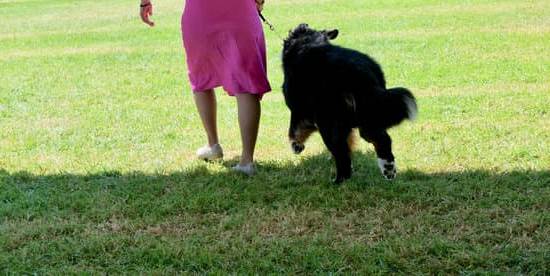Training a dog to use the potty pad is an essential skill for both pets and pet owners. Potty pads offer convenience and flexibility, especially for those who live in apartments or have busy schedules. Understanding the purpose of potty pads is the first step in successful training. These pads are designed to mimic outdoor grass areas and provide a designated spot for your dog to relieve themselves indoors.
By teaching your dog to use a potty pad, you can minimize accidents in the house and maintain a clean living environment. Not only does it benefit your home’s hygiene, but it also promotes good behavior and reinforces boundaries for your furry friend.
In this article, we will explore the benefits of using potty pads for dogs, as well as provide tips on setting up the perfect potty pad area in your home and choosing the right type of pad for your pet.
Setting up a dedicated potty pad area involves more than just placing a pad on the floor. It requires careful consideration of factors such as accessibility, cleanliness, and consistency.
By creating a comfortable and inviting space for your dog to use the potty pad, you can encourage them to develop positive habits. Stay tuned as we delve into step-by-step guides on introducing your dog to the potty pad and effective training techniques to ensure success in using this convenient indoor solution.
Benefits of Using Potty Pads for Dogs
Potty pads for dogs are a convenient and effective solution for pet owners who live in apartments, have busy schedules, or are unable to take their furry friends outside frequently. Understanding the benefits of using potty pads can help you make an informed decision on whether they are the right choice for your dog’s potty training needs.
- Convenience: Potty pads provide a designated spot for your dog to relieve themselves indoors, eliminating the need for frequent trips outside, especially during extreme weather conditions or late at night.
- Flexibility: With potty pads, you can train your dog to use them at any time of the day, making it easier to maintain consistency in their potty training routine.
- Training assistance: Potty pads can be a valuable tool in housebreaking puppies or senior dogs who may have difficulty holding their bladder for extended periods.
When setting up the perfect potty pad area in your home, consider placing the pads in a quiet and easily accessible location for your dog. Make sure to keep the area clean and free of any distractions that may deter your dog from using the pad. Additionally, choose a spot that is easy to clean and maintain to ensure that your dog always has a comfortable and hygienic place to go potty.
Overall, incorporating potty pads into your dog’s training routine can lead to successful indoor potty training. By following a step-by-step guide on introducing your dog to the pad and utilizing various training tips and techniques, you can effectively teach your furry companion how to use the potty pad consistently. Remember to be patient and consistent with your training efforts to help establish a routine that works best for both you and your four-legged friend.
Setting Up the Perfect Potty Pad Area in Your Home
When setting up the potty pad area, make sure it is large enough for your dog to comfortably move around on. You may want to consider using a tray or holder underneath the potty pad to prevent any leaks or spills onto your floors. Additionally, placing the potty pad near an exit can help reinforce the idea of going outside when it’s time for bathroom breaks.
To further encourage your dog to use the potty pad, consider adding some of their favorite toys or blankets nearby. This will create a positive association with the area and make them feel more comfortable using it. Remember that consistency is key when training your dog to use the potty pad, so having a well-thought-out area can make the process smoother and more effective.
| Benefit | Detail |
|---|---|
| Convenient Location | Choose a spot easily accessible to your pet but away from food and water dishes |
| Adequate Size | Ensure the potty pad area is large enough for your dog to move around comfortably |
| Positive Association | Add toys or blankets nearby to create a welcoming environment for your dog |
Choosing the Right Type of Potty Pad for Your Dog
When training your dog to use a potty pad, choosing the right type of pad is crucial for the success of your training efforts. There are various options available in the market, each with its own characteristics and benefits. Understanding the different types of potty pads will help you make an informed decision based on your dog’s needs and preferences.
Disposable Potty Pads
Disposable potty pads are convenient and easy to use. Made from absorbent materials, these pads are ideal for quick clean-up and disposal after each use. They come in various sizes to accommodate different breeds and can be a great option for busy pet owners or apartment dwellers without access to outdoor spaces.
Washable Reusable Potty Pads
Washable reusable potty pads are environmentally friendly options that can save you money in the long run. These pads are typically made from durable materials that can withstand multiple washings, reducing waste and providing a sustainable solution for potty training your dog. They may require more maintenance compared to disposable pads but offer a cost-effective alternative for pet owners looking for a more eco-friendly option.
Scented Potty Pads
Scented potty pads are designed to attract dogs with their appealing scent, encouraging them to use the pad regularly. The scent helps establish a connection between the pad and the act of elimination, making it easier for your dog to understand where they should go potty.
If your dog is hesitant to use regular potty pads, scented pads can be a helpful solution to expedite the training process and make it more effective. Remember to consider your dog’s preferences and sensitivities when selecting scented options, as some dogs may not respond well to strong smells.
Introducing Your Dog to the Potty Pad
When it comes to training your dog to use a potty pad, patience and consistency are key. Here’s a step-by-step guide on how to successfully introduce your furry friend to this new bathroom routine:
1. Choose the Right Location: Select a designated area in your home where you will place the potty pad. Make sure it is easily accessible for your dog but also away from their food and sleeping areas. This will help them associate that spot specifically for potty time.
2. Familiarize Your Dog with the Pad: Place the potty pad in the chosen location and let your dog explore it at their own pace. Allow them to sniff and investigate the pad to get comfortable with it being there.
3. Encourage Positive Associations: Whenever you see your dog using the potty pad, shower them with praise, affection, and treats as positive reinforcement. This will help create a positive association with using the pad.
4. Redirect Accidents: If you catch your dog having an accident outside of the potty pad area, gently redirect them to the pad without scolding or punishing them. Consistency is key in reinforcing where they should be going.
By following these steps and remaining consistent in your training efforts, you can effectively teach your dog how to use the potty pad for their bathroom needs. Remember that every dog is different, so be patient and understanding throughout this training process.
Training Tips and Techniques to Encourage Potty Pad Use
Training your dog to use a potty pad can be a convenient solution for pet owners who may not have easy access to outdoor spaces or those with busy schedules. Here are some tips and techniques to help you successfully train your furry friend to use the potty pad effectively.
Consistency is key when it comes to potty pad training. Establish a routine for feeding, playtime, and potty breaks to help your dog understand when it’s time to use the potty pad. Take your dog to the potty pad after meals, upon waking up, and before bedtime. Praise and reward your dog with treats or verbal praise every time they successfully use the potty pad. Positive reinforcement will help reinforce good behavior.
Another crucial aspect of training your dog to use the potty pad is supervision. Keep an eye on your dog, especially during the initial stages of training, to prevent accidents. If you catch your dog in the act of using the potty pad, praise them immediately and offer a treat.
If accidents happen outside of designated potty pad times, do not scold or punish your dog. Simply clean up the mess thoroughly to remove any scent markers that might attract them back to the same spot.
To make using the potty pad more appealing to your dog, consider using attractants like special sprays designed to draw dogs towards designated elimination areas. These products emit scents that mimic urine markers, encouraging dogs to use the potty pads consistently.
Additionally, if you notice that your dog is struggling with using the potty pad in a specific location, try relocating it to a more accessible or private area. By following these training tips and techniques consistently, you can effectively teach your dog how to use the potty pad with patience and positive reinforcement.
| Key Points | Details |
|---|---|
| Consistency | Establish a routine for feeding, playtime, and potty breaks. |
| Supervision | Keep an eye on your dog during training stages to prevent accidents. |
| Attractants | Consider using special sprays as attractants on the potty pads. |
Dealing With Accidents and How to Handle Them
Accidents are a natural part of the potty training process when teaching your dog to use a potty pad. It is important to approach these incidents with patience and understanding, as scolding or punishing your dog can create anxiety and hinder their progress. Instead, it’s essential to handle accidents calmly and effectively to reinforce positive behavior.
Immediate Response
When you catch your dog in the act of having an accident outside the designated potty pad area, calmly but firmly interrupt them by saying “No” or making a loud noise to startle them. Then, quickly guide them to the potty pad area to show them where they should go. Avoid yelling or showing frustration, as this can confuse your dog and make them afraid of using the potty pad.
Cleaning Up
It is crucial to clean up accidents promptly and thoroughly to remove any scent markers that may attract your dog back to the same spot. Use an enzymatic cleaner specifically designed for pet stains and odors to ensure all traces are eliminated. Proper cleaning not only prevents repeat accidents but also helps maintain a hygienic environment for both you and your furry friend.
Reassessing Your Training Approach
If accidents continue to occur frequently despite consistent training efforts, take a step back and reassess your training approach. It may be necessary to revisit some of the earlier steps in introducing your dog to the potty pad or adjust your routine to better meet your dog’s needs. Remember that every dog is unique, so be patient and flexible in finding what works best for them.
Establishing a Routine for Potty Pad Training
Establishing a routine is crucial when it comes to potty pad training for your dog. Consistency is key in reinforcing positive behavior and helping your furry friend understand where they are supposed to go potty. The first step in establishing a routine is to determine specific times throughout the day when your dog is most likely to need to use the potty pad. This could be after meals, upon waking up, or before bedtime.
Once you have identified these key times, make sure to take your dog to the designated potty pad area consistently at those times every day. By doing so, you are helping them associate that spot with going potty. Additionally, be sure to provide plenty of positive reinforcement such as treats or praise when your dog successfully uses the potty pad. This will help reinforce the desired behavior and encourage them to repeat it in the future.
In addition to scheduled potty breaks, keep an eye out for signs that indicate your dog may need to go potty, such as sniffing around or circling a specific area. If you notice these behaviors, quickly guide your dog to the potty pad area.
As your dog becomes more accustomed to using the potty pad, gradually increase the time between scheduled breaks while still monitoring for cues that they need to go. With patience and a consistent routine, you can effectively train your dog to use the potty pad in no time.
Troubleshooting Common Issues and Challenges
Training a dog to use a potty pad can sometimes present challenges along the way. One common issue that pet owners may face is resistance from their furry friends. Some dogs may initially show reluctance or hesitation to use the potty pad, especially if they are used to eliminating outside or on other surfaces.
In such cases, patience and consistency are key. It’s essential to remember that every dog is different and may require varying amounts of time to adjust to using the potty pad.
Another challenge that pet owners might encounter is inconsistent or erratic behavior from their dogs when it comes to using the potty pad. This inconsistency can be frustrating but is not uncommon during the training process.
One effective way to address this issue is by closely monitoring your dog’s bathroom habits and identifying patterns or triggers that lead them to use or avoid the potty pad. By understanding your dog’s preferences and routines, you can tailor your training approach accordingly to promote more consistent usage of the potty pad.
Additionally, some dogs may exhibit territorial behaviors or marking tendencies, leading them to reject using a designated area like a potty pad for their needs. In such cases, it’s crucial to establish clear boundaries and reinforce positive behaviors through positive reinforcement techniques.
Consistently praise and reward your dog whenever they successfully use the potty pad, creating a positive association with the designated area. With patience, persistence, and understanding, you can overcome these challenges and successfully train your dog to use the potty pad effectively.
Celebrating Success
In conclusion, celebrating success is an important aspect of potty pad training for your dog. This positive reinforcement can help solidify the behavior you want to encourage and motivate your furry friend to continue using the potty pad consistently. By rewarding your dog with treats, praise, or playtime each time they successfully use the potty pad, you are reinforcing their good behavior and strengthening the training process.
It is essential to remember that consistency is key when it comes to potty pad training. Stick to a routine and be patient with your dog as they learn this new skill. Every dog is different, so some may pick up on using the potty pad quickly while others may take a little longer. Stay committed to the training process and be prepared for setbacks along the way.
Overall, training your dog to use the potty pad requires time, patience, and dedication. By following the step-by-step guide, utilizing training tips and techniques, establishing a routine, and troubleshooting common issues that may arise, you can successfully train your dog to use the potty pad. Remember that accidents will happen but stay positive and focus on rewarding positive behavior to help your dog succeed in using the potty pad consistently.
Frequently Asked Questions
How Do I Train My Dog to Pee on a Pee Pad?
Training your dog to pee on a pee pad requires patience and consistency. Start by placing the pee pad in a specific location and encouraging your dog to use it after meals, naps, and playtime. Use positive reinforcement like treats and praise when they successfully go on the pad.
How Do I Attract My Dog to Pee Pad?
To attract your dog to use the pee pad, you can try using potty training sprays or attractants specifically designed for this purpose. These products contain scents that mimic those found in urine, which can help encourage your dog to use the pad.
Additionally, placing some of your dog’s urine or feces on the pad can also serve as a natural attractant.
How Long Does It Take to Potty Pad Train a Dog?
The time it takes to potty pad train a dog can vary depending on factors such as age, breed, and individual temperament. Generally, it may take anywhere from a few weeks to several months for a dog to fully grasp using a pee pad consistently.
It’s important to be patient, provide ample opportunities for your dog to use the pad, and reinforce good behavior with rewards.

Welcome to the blog! I am a professional dog trainer and have been working with dogs for many years. In this blog, I will be discussing various topics related to dog training, including tips, tricks, and advice. I hope you find this information helpful and informative. Thanks for reading!





